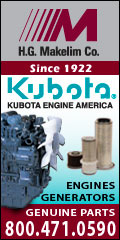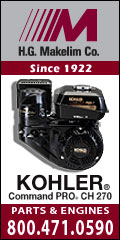
| Past Issues/Subscribe | Advertise |
Tier 4 Basics: What To Expect
When will these Tier 4 changes go into effect? Beginning Jan. 1, 2011, engines greater than 174 horsepower (130 kW) needed to meet Tier 4 Interim requirements. For engines in the 75 to 174 horsepower (57 to 130 kW) range, Tier 4 Interim requirements take effect Jan. 1, 2012. Tier 4 Final requirements take effect Jan. 1, 2014. Why is the EPA making these changes? NOx is produced during combustion when the engine is at its hottest. PM – tiny carbon particles and other poisonous substances – is created when not all fuel is burned during combustion, usually when the engine is cooler. When inhaled repeatedly, these small particles may aggravate asthma and allergies or cause other serious health problems. Will I still be able to buy older equipment from my dealership? What will this mean for trade-ins of older equipment? How are the new engines different from the old ones? In an SCR system, the engine is tuned for maximum efficiency. The higher combustion temperatures reduce PM levels but increase NOx levels. SCR is an after-treatment-only system that creates a chemical reaction by adding diesel exhaust fluid (DEF). This transforms the NOx into nitrogen and water, which occur naturally in the atmosphere. No particulate filter is required because PM levels are low due to the higher combustion temperatures. Selective catalytic reduction allows for a cool-running, quiet system that’s separate from the main engine function and does not compromise horsepower or torque. It does not interfere with engine performance, and actually improves performance, because it allows the engine to breathe more freely. The SCR after-treatment system requires the addition of diesel exhaust fluid (DEF). The after-treatment system is composed of a supply module, a DEF tank, a dosing module and an SCR catalyst. The second technology option for meeting Tier 4 Interim requirements is the cooled exhaust gas recirculation approach. In a CEGR system, exhaust gases are cooled, blended with fresh air and then returned to the cylinder, lowering combustion temperatures and dramatically reducing NOx. The cooler combustion temperature results in a higher PM level, which is then reduced through the use of an after-treatment diesel particulate filter (DPF) system. The DPF requires periodic regeneration for optimal operation. This re-gen process is usually automatic, without requiring operator intervention. The article reported that Case sees advantages to both technologies, depending on engine size and load, and application demands. Case applys the technology that achieves the lowest operating costs, depending on each model’s engineering characteristics and application requirements. Their solutions integrate each model’s engine, hydraulic and electronic systems to achieve the most efficient and powerful performance. How will the new standards be monitored? Will it change the way I manage my equipment? What will the Tier 4 regulations accomplish (the long-term benefits)?
|

| calrental.org |


